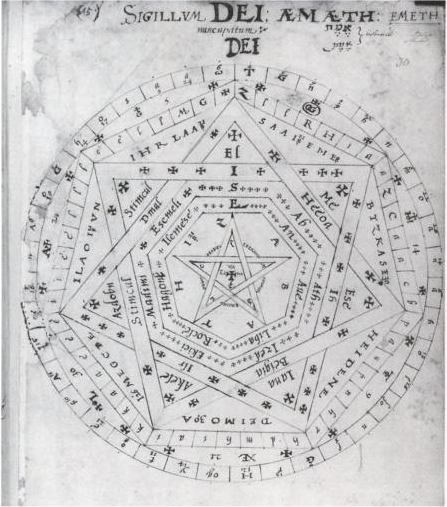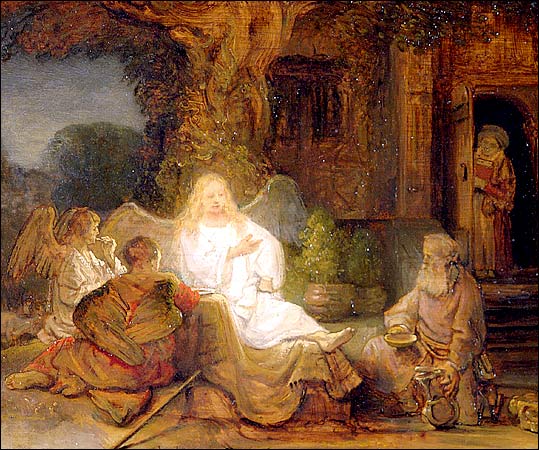|
Sigillum Dei
The Sigillum Dei (seal of God, or signum dei vivi, symbol of the living God, called by John Dee the Sigillum Dei Aemeth) is a magical diagram, composed of two circles, a pentagram, two heptagons, and one heptagram, and is labeled with the name of God and his angels. It was an amulet (''amuletum'') with the magical function that, according to one of the oldest sources (''Liber Juratus''), allowed the initiated magician to have the power to commune with angels and archangels (''beatific visionary''). Middle Ages Liber Juratus Probably the oldest known description and image of the ''Sigillum Dei'' is the 14th Century ''Liber Juratus'' (also ''Liber Sacratus'', ''Liber sacer sive Juratus'', or Sworn Booke), attributed to Honorius, son of Euclid. This may have been produced in the late 13th century, but likely not before the time of Pope John XXII. (1316–1334). The description of the seal in the ''Liber Juratus'' begins with the dimensions of the circle surrounding the outside in ... [...More Info...] [...Related Items...] OR: [Wikipedia] [Google] [Baidu] |
Seven Archangels
The concept of Seven Archangels is found in some works of early Jewish literature and in Christianity. In those texts, they are referenced as the angels who serve God directly. Bible The term ''archangel'' itself is not found in the Hebrew Bible or the Christian Old Testament, and in the Greek New Testament the term ''archangel'' only occurs in and the , where it is used of Michael, who in is called 'one of the chief princes,' and 'the great prince'. In the Septuagint this is rendered "the great angel." The idea of seven archangels is most explicitly stated in the deuterocanonical Book of Tobit when Raphael reveals himself, declaring: "I am Raphael, one of the seven angels who stand in the glorious presence of the Lord, ready to serve him." () The other two angels mentioned by name in the Bible are archangel Michael and angel Gabriel. The four names of other archangels come from tradition. tells about "seven rejoices" that are "the eyes of the Lord, Which scan to and from ... [...More Info...] [...Related Items...] OR: [Wikipedia] [Google] [Baidu] |
Bodleian Library
The Bodleian Library () is the main research library of the University of Oxford, and is one of the oldest libraries in Europe. It derives its name from its founder, Sir Thomas Bodley. With over 13 million printed items, it is the second-largest library in Britain after the British Library. Under the Legal Deposit Libraries Act 2003, it is one of six legal deposit libraries for works published in the United Kingdom, and under Irish law it is entitled to request a copy of each book published in the Republic of Ireland. Known to Oxford scholars as "Bodley" or "the Bod", it operates principally as a reference library and, in general, documents may not be removed from the reading rooms. In 2000, a number of libraries within the University of Oxford were brought together for administrative purposes under the aegis of what was initially known as Oxford University Library Services (OULS), and since 2010 as the Bodleian Libraries, of which the Bodleian Library is the largest ... [...More Info...] [...Related Items...] OR: [Wikipedia] [Google] [Baidu] |
Heimann Joseph Michael
Heimann (Hayyim) Michael (April 12, 1792 – June 10, 1846) was a Hebrew bibliographer born at Hamburg. He showed great acuteness of mind in early childhood, had a phenomenal memory, and was an indefatigable student. He studied Talmudics and received private instruction in all the branches of a regular school education. He was a born bibliophile, and began to collect valuable works when still a boy of twelve. With his progress in Hebrew literature his love for books increased also, the result of which was his magnificent library of 862 manuscripts and 5,471 printed works, covering all branches of Hebrew literature. There were few books in his collection which he had not read, and he undertook the preparation of a full catalog of it. As far as he accomplished this task, it was the foundation of the ''Ozerot Hayyim, Katalog der Michael'schen Bibliothek'', Hamburg, 1848. Michael took an interest not only in Jewish literature, but in all the intellectual movements of the day, as is s ... [...More Info...] [...Related Items...] OR: [Wikipedia] [Google] [Baidu] |
Italian Language
Italian (''italiano'' or ) is a Romance language of the Indo-European language family that evolved from the Vulgar Latin of the Roman Empire. Together with Sardinian, Italian is the least divergent language from Latin. Spoken by about 85 million people (2022), Italian is an official language in Italy, Switzerland ( Ticino and the Grisons), San Marino, and Vatican City. It has an official minority status in western Istria (Croatia and Slovenia). Italian is also spoken by large immigrant and expatriate communities in the Americas and Australia.Ethnologue report for language code:ita (Italy) – Gordon, Raymond G., Jr. (ed.), 2005. Ethnologue: Languages of the World, Fifteenth edition. Dallas, Tex.: SIL International. Online version ... [...More Info...] [...Related Items...] OR: [Wikipedia] [Google] [Baidu] |
Key Of Solomon
The ''Key of Solomon'' ( la, Clavicula Salomonis; he, מפתח שלמה []) (Also known as "The Greater Key of Solomon") is a pseudepigraphical grimoire (also known as a book of spells) attributed to Solomon, King Solomon. It probably dates back to the 14th or 15th century Italian Renaissance. It presents a typical example of Renaissance magic. It is possible that the ''Key of Solomon'' inspired later works, particularly the 17th-century grimoire also known as ''Clavicula Salomonis Regis'', ''The Lesser Key of Solomon'', or ''Lemegeton'', although there are many differences between the books. Manuscripts and textual history Many such grimoires attributed to King Solomon were written during the Renaissance, ultimately being influenced by earlier works of Jewish kabbalists and Arab magicians. These, in turn, incorporated aspects of the Greco-Roman magic of Late Antiquity. Several versions of the ''Key of Solomon'' exist, in various translations, with minor to significant diffe ... [...More Info...] [...Related Items...] OR: [Wikipedia] [Google] [Baidu] |
Gabriel (archangel)
In Abrahamic religions (Judaism, Christianity and Islam), Gabriel (); Greek: grc, Γαβριήλ, translit=Gabriḗl, label=none; Latin: ''Gabriel''; Coptic: cop, Ⲅⲁⲃⲣⲓⲏⲗ, translit=Gabriêl, label=none; Amharic: am, ገብርኤል, translit=Gabrəʾel, label=none; arc, ܓ݁ܰܒ݂ܪܺܝܐܝܶܠ, translit=Gaḇrīʾēl; ar, جِبْرِيل, Jibrīl, also ar, جبرائيل, Jibrāʾīl or ''Jabrāʾīl'', group="N" is an archangel with power to announce God's will to men. He is mentioned in the Hebrew Bible, the New Testament, and the Quran. Many Christian traditions — including Anglicanism, Eastern Orthodoxy, and Roman Catholicism — revere Gabriel as a saint. In the Hebrew Bible, Gabriel appears to the prophet Daniel to explain his visions (Daniel 8:15–26, 9:21–27). The archangel also appears in the Book of Enoch and other ancient Jewish writings not preserved in Hebrew. Alongside the archangel Michael, Gabriel is described as the guardian ... [...More Info...] [...Related Items...] OR: [Wikipedia] [Google] [Baidu] |
Michael (archangel)
Michael (; he, מִיכָאֵל, lit=Who is like El od, translit=Mīḵāʾēl; el, Μιχαήλ, translit=Mikhaḗl; la, Michahel; ar, ميخائيل ، مِيكَالَ ، ميكائيل, translit=Mīkāʾīl, Mīkāl, Mīkhāʾīl), also called Saint Michael the Archangel, Saint Michael the Taxiarch in Orthodoxy and Archangel Michael is an archangel in Judaism, Christianity, Islam and the Baha'i faith. The earliest surviving mentions of his name are in 3rd- and 2nd-century BC Jewish works, often but not always apocalyptic, where he is the chief of the angels and archangels and responsible for the care of Israel. Christianity adopted nearly all the Jewish traditions concerning him, and he is mentioned explicitly in Revelation 12:7–12, where he does battle with Satan, and in the Epistle of Jude, where the author denounces heretics by contrasting them with Michael. Second Temple Jewish writings The earliest surviving mention of Michael is in a 3rd century BC Jewis ... [...More Info...] [...Related Items...] OR: [Wikipedia] [Google] [Baidu] |
Haniel
Haniel ( he, חַנִּיאֵל, ''Ḥannīʾēl'', "God is my grace"; cop, ⲁⲛⲁⲛⲓⲏⲗ ''Ananiēl''; ar, عنيائيل, '), also known as Hananel, Anael, Hanael or Aniel, is an angel in Jewish lore and angelology, and is often included in lists as being one of the seven archangels. Haniel is generally associated with the planet Venus, and is the archangel of the sephirah Netzach. The name Haniel derives from the Hebrew ''Ḥēn'' (חֵן), meaning "grace, favour, charm" (qualities associated with Venus) + the suffix ''-ʾĒl,'' "God". It is equivalent to the Phoenician name " Hannibal." Haniel is one of the archangels encrypted in the Sigillum Dei Aemeth of Dr. John Dee and Edward Kelly. Popular culture * Haniel (as Anael) appears in the strategy RPG '' Shin Megami Tensei: Devil Survivor'' as a boss depending on which route the player takes. All of her appearances are made alongside Sariel. Although angels, they take on appearances typical of "grim reaper" vis ... [...More Info...] [...Related Items...] OR: [Wikipedia] [Google] [Baidu] |
Raphael (archangel)
Raphael (, "God has healed"), ''Rəfāʾēl'', Tiberian: ''Răp̄āʾēl''; lit. 'God has healed'; grc, Ραφαήλ, ''Raphaḗl''; cop, ⲣⲁⲫⲁⲏⲗ, ''Rafaêl''; ar, رافائيل, ''Rāfā’īl'', or , ''Isrāfīl''; am, ሩፋኤል, ''Rufaʾel''. is an archangel first mentioned in the Book of Tobit and in 1 Enoch, both estimated to date from between the 3rd and 2nd century BCE. In later Jewish tradition, he became identified as one of the three heavenly visitors entertained by Abraham at the Oak of Mamre. He is not named in either the New Testament or the Quran, but later Christian tradition identified him with healing and as the angel who stirred waters in the Pool of Bethesda in John 5:2–4, and in Islam, where his name is Israfil, he is understood to be the unnamed angel of Quran 6:73, standing eternally with a trumpet to his lips, ready to announce the Day of Judgment. In Gnostic tradition, Raphael is represented on the Ophite Diagram. Origins in pos ... [...More Info...] [...Related Items...] OR: [Wikipedia] [Google] [Baidu] |
Samael
Samael ( he, סַמָּאֵל, ''Sammāʾēl'', "Venom/Poison of God"; ar, سمسمائيل, ''Samsama'il'' or ar, سمائل, label=none, ''Samail''; alternatively Smal, Smil, Samil, or Samiel) is an archangel in Talmudic and post-Talmudic lore; a figure who is the accuser or adversary (Satan as mentioned in the Book of Job), seducer, and destroyer ( Mashhit as mentioned in the Book of Exodus). Although many of his functions resemble the Christian notion of Satan, to the point of being sometimes identified as a fallen angel, he is not necessarily evil, since his functions are also regarded as resulting in good, such as destroying sinners. He is considered in Midrashic texts to be a member of the heavenly host with often grim and destructive duties. One of Samael's greatest roles in Jewish lore is that of the main angel of death and the head of ''satans''. Although he condones the sins of man, he remains one of God's servants. He appears frequently in the story of the Garde ... [...More Info...] [...Related Items...] OR: [Wikipedia] [Google] [Baidu] |
Zadkiel
Zadkiel ( he, צִדְקִיאֵל , 'God is my Righteousness'), also known as Hasdiel, is the archangel of freedom, benevolence, kindness and mercy, and the patron angel of all who forgive. Names Zadkiel is also known by a variety of other names. Among them are Hasdiel, Sachiel, Zedekiel, Zadakiel, Tzadkiel, and Zedekul. Hierarchy In rabbinic writings, Zadkiel belongs to the order of Hashmallim. He is considered by some sources to be chief of that order although others name Hashmal or Zacharael. In ''Maseket Azilut,'' it is listed as co-chief with Gabriel of the order of ''Shinanim''. Zadkiel is one of two standard bearers (along with Jophiel) who follow directly behind Michael as the head archangel enters battle. Abraham sacrifice As an angel of mercy, some texts claim that Zadkiel is the unnamed biblical Angel of the Lord who holds back Abraham to prevent the patriarch from sacrificing his son, and because of this is usually shown holding a dagger. Other text ... [...More Info...] [...Related Items...] OR: [Wikipedia] [Google] [Baidu] |

.jpg)




.jpg)



